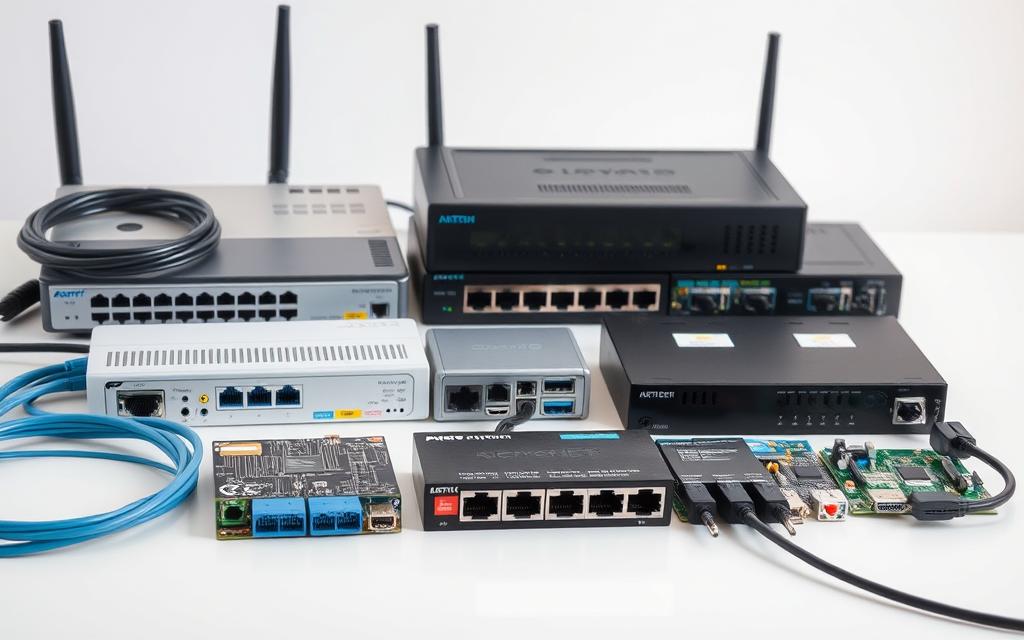Modern IT systems rely on physical equipment to connect and communicate efficiently. These tools, often referred to as computer network hardware, form the backbone of data exchange. They include routers, switches, modems, and other essential devices.
These components ensure seamless communication between systems, enabling businesses and individuals to collaborate effectively. Choosing the right devices is crucial for optimal performance, security, and scalability.
Emerging trends like IoT integration and advanced security features are reshaping the landscape. Understanding the role of these tools helps in building robust and future-ready IT infrastructures.
Introduction to Computer Network Hardware
The backbone of modern connectivity lies in the tools that manage data flow. These physical devices ensure seamless communication across systems, whether within a local office or across global networks. By directing data packets efficiently, they form the foundation of reliable operations.
Over the years, these tools have evolved significantly. Early analog modems have been replaced by high-speed fiber-optic routers, enhancing efficiency and speed. This shift has enabled faster data transfer, supporting the demands of today’s digital landscape.
In today’s world, these devices play a critical role in supporting remote work and cloud-based systems. They ensure that teams can collaborate effectively, regardless of location. The quality of these tools directly impacts user experience, reducing latency and improving overall performance.
Proper configuration is equally important. It not only enhances reliability but also strengthens security. By understanding how these devices work, businesses can build robust infrastructures that meet their needs both now and in the future.
What Is Computer Network Hardware?
Physical tools that enable seamless data exchange are essential for modern connectivity. These components, often referred to as network hardware, facilitate the interconnection of devices and the efficient transfer of information. They play a critical role in ensuring smooth communication across systems.
Definition and Purpose
Network hardware includes physical devices like routers, switches, and modems. These tools are designed to manage data packets, ensuring they reach their intended destinations. Their primary purpose is to minimize collisions and optimize bandwidth usage, enhancing overall system performance.
Protocols like TCP/IP have standardized how these devices connect and communicate. This standardization ensures compatibility across different systems, making it easier to build scalable and reliable infrastructures.
Historical Context
Early networks relied on coaxial cables and basic hubs to amplify signals. These systems were limited in speed and efficiency. Over time, advancements like ethernet and wireless technologies revolutionized connectivity.
Modern systems use Layer 3 switches for intelligent routing and AI-driven routers for traffic management. This evolution has enabled faster data transfer and improved reliability, meeting the demands of today’s digital landscape.
| Era | Technology | Key Features |
|---|---|---|
| 1980s | Coaxial Cables | Basic signal amplification |
| 2000s | Ethernet | High-speed wired connections |
| Present | Wi-Fi 6E & 5G | Wireless, high-speed, low latency |
The transition from wired hubs to wireless access points has further enhanced flexibility and accessibility. Today, these tools support everything from remote work to IoT integration, making them indispensable in modern IT systems.
Key Components of Computer Network Hardware
Effective data exchange relies on specific devices that manage connectivity. These tools ensure seamless communication across systems, enabling efficient operations. Below, we explore the essential components that form the backbone of modern IT infrastructures.
Routers
Routers direct traffic between networks using IP addresses. They feature built-in firewalls and use Access Control Lists (ACLs) for traffic filtering. This ensures secure and efficient data transfer across different systems.
Switches
Switches use MAC addresses to forward data within Local Area Networks (LANs). Power over Ethernet (PoE) variants can also power IoT devices, making them versatile tools for modern setups.
Modems
Modems convert analog signals to digital and vice versa. Cable modems offer faster speeds compared to DSL, ensuring reliable internet connectivity for users.
Hubs
Hubs are legacy devices that broadcast data to all ports, often causing collisions. While largely replaced by switches, they still serve in specific scenarios.
Bridges
Bridges reduce congestion by segmenting LANs. They filter traffic using MAC tables, ensuring efficient data flow between network segments.
| Component | Function |
|---|---|
| Routers | Direct traffic between networks using IP addresses |
| Switches | Forward data within LANs using MAC addresses |
| Modems | Convert analog/digital signals for internet connectivity |
| Hubs | Broadcast data to all ports, causing collisions |
| Bridges | Segment LANs to reduce congestion |
The Role of Network Hardware in Modern Networking
The foundation of seamless connectivity relies on robust devices that manage data flow. These tools ensure efficient communication across systems, enabling businesses and individuals to stay connected. From routers to switches, each component plays a vital role in maintaining smooth operations.
Facilitating Communication
Routers prioritize critical traffic, such as video conferencing, over less urgent tasks like file downloads. This ensures uninterrupted communication during meetings or presentations. Managed switches further enhance efficiency by reducing latency through Quality of Service (QoS) settings.
Switch buffer optimization prevents packet loss during peak usage, ensuring reliable data transmission. This is especially important for applications like 4K streaming and virtual reality, which demand high bandwidth and low latency.
Enhancing Network Performance
Hardware plays a crucial role in supporting modern applications. For example, VLAN configurations isolate sensitive departments like finance, enhancing security and network performance. Redundant switches in hospitals maintain uptime for Electronic Health Record (EHR) systems, ensuring critical data is always accessible.
Routers balance loads across multiple paths, optimizing efficiency and reducing bottlenecks. This ensures that connected devices operate smoothly, even during high-demand periods.
| Component | Function |
|---|---|
| Routers | Prioritize traffic and balance loads |
| Switches | Optimize buffers and reduce latency |
| VLANs | Isolate sensitive data for security |
Types of Network Hardware and Their Functions
Efficient data transfer relies on specialized devices designed to manage connectivity. These tools ensure seamless communication and optimize performance across systems. Understanding their roles helps in building robust infrastructures tailored to specific needs.
Routers vs. Switches
Routers connect multiple networks, such as linking a LAN to an ISP. They use IP addresses to direct traffic, ensuring data reaches its destination efficiently. Advanced models, like SD-WAN routers, are used by retail chains for centralized cloud management.
Switches, on the other hand, manage intra-network traffic. They use MAC addresses to forward data within a LAN. Layer 3 switches combine routing and switching capabilities, offering enhanced flexibility for complex setups.
Unmanaged switches are ideal for small businesses, while smart switches cater to enterprises with advanced needs. This distinction ensures scalability and cost-effectiveness for different organizational sizes.
Firewalls and Security
Firewalls play a critical role in safeguarding systems. Hardware variants inspect packets at wire speed, blocking malicious traffic in real-time. Next-Generation Firewalls (NGFWs) use AI to detect and block zero-day exploits, enhancing network security.
Unified Threat Management (UTM) devices combine features like Intrusion Prevention Systems (IPS) and Intrusion Detection Systems (IDS). These tools provide comprehensive protection, ensuring secure access to resources.
By integrating these devices, businesses can create layered defenses against cyber threats. This approach not only protects sensitive data but also ensures uninterrupted operations.
Configuring Network Hardware for Optimal Performance
Proper setup of devices ensures seamless data flow and peak performance. Effective configuration not only enhances speed but also minimizes errors that can disrupt operations. By following best practices, businesses can avoid common pitfalls and maintain reliable connectivity.
Best Practices for Configuration
To achieve optimal results, start by assigning static IPs to critical servers. Use DHCP for endpoints to simplify management. This approach ensures that essential systems remain accessible while maintaining flexibility for other devices.
Enable port security on switches to prevent unauthorized access. This step is crucial for safeguarding sensitive data and maintaining the integrity of your network interface. Regularly updating firmware is another key practice, as it patches vulnerabilities like CVE-2023-28771 in routers.
- Use a star topology with managed switches instead of daisy-chaining hubs.
- Adjust Quality of Service (QoS) settings to prioritize critical traffic.
- Monitor and optimize VLAN configurations to avoid broadcast storms.
Common Configuration Mistakes
Misconfigured Access Control Lists (ACLs) can block legitimate traffic, causing delays and frustration. Similarly, improper VLAN tagging often leads to broadcast storms, which overwhelm the system and degrade performance.
Another frequent error is neglecting to update firmware. Outdated software leaves devices vulnerable to exploits, compromising security and reliability. Avoid these mistakes by adhering to best practices and conducting regular audits.
Case Study: A company resolved a 30% latency drop by adjusting QoS settings. This highlights the importance of proper configuration in maintaining optimal performance across multiple devices.
Network Hardware and Network Security
Ensuring robust protection for digital systems is a top priority in today’s interconnected world. Devices like routers, switches, and firewalls are equipped with advanced security features to safeguard sensitive information. These tools are essential for maintaining the integrity of any area network.
Security Features in Network Hardware
Modern devices come with built-in protections to combat cyber threats. MAC filtering, for instance, blocks unauthorized devices from accessing the system. VPN appliances encrypt remote connections, ensuring secure access to resources from any location.
Other features include hardware-based intrusion prevention systems (IPS) deployed at network edges. These systems monitor data packets in real-time, identifying and neutralizing potential threats before they cause harm.
Protecting Against Cyber Threats
Activating WPA3 encryption on wireless access points is a critical step in enhancing security. This protocol provides stronger protection against unauthorized access compared to older standards.
Implementing Zero Trust via 802.1X authentication on switches ensures that only verified devices can connect. Financial firms often use hardware security modules (HSMs) to encrypt transactions, adding an extra layer of protection.
- Deploy NICs with TCP offload engines to reduce CPU load during DDoS attacks.
- Regularly update firmware to patch vulnerabilities and maintain system integrity.
- Use VLANs to isolate sensitive data and minimize exposure to threats.
Future Trends in Network Hardware
The evolution of connectivity tools is reshaping how data is managed and transmitted globally. Emerging technologies are driving significant changes, enhancing performance and expanding capabilities. From IoT integration to quantum networking, these advancements are setting the stage for a more connected and efficient future.
Impact of IoT on Network Hardware
The rise of IoT is transforming the way devices interact within an area network. Smart cities are leveraging LoRaWAN gateways to connect IoT sensors, enabling real-time data collection and analysis. This integration requires low-latency routers and switches to ensure seamless communication.
Edge computing is another key driver, pushing demand for 5G routers that process data closer to the source. This reduces latency and supports applications like autonomous vehicles and industrial automation. “The rollout of 5G networks is revolutionizing connectivity,” notes a recent report on 2023 computer networking equipment trends.
Advancements in Network Hardware Technology
Wi-Fi 7 routers are set to deliver speeds of up to 46 Gbps, significantly enhancing performance for high-bandwidth applications. Quantum networking hardware is also entering R&D phases, promising unprecedented security and speed.
AIOps platforms are automating switch configurations using machine learning algorithms, improving efficiency and reducing manual intervention. Energy-efficient hardware, compliant with ISO 50001 standards, is addressing sustainability concerns while maintaining high performance.
- Predictive maintenance in NICs uses embedded diagnostics to prevent failures.
- SDN (Software-Defined Networking) offers flexibility by decoupling control from hardware.
- Wi-Fi 6E provides faster speeds and better performance in crowded environments.
These innovations are not just enhancing current systems but also paving the way for future technologies like 6G, which promises even higher data rates and lower latency.
Conclusion
Building a reliable digital infrastructure requires understanding the core tools that drive connectivity. Routers, switches, and firewalls form the backbone of any system, ensuring seamless communication and robust security. These components are essential for maintaining performance and safeguarding data.
Regular audits and compliance checks are critical to identify vulnerabilities and optimize operations. Adopting SDN-ready hardware ensures scalability, preparing systems for future demands. Energy-efficient solutions also help balance upfront costs with long-term savings.
By focusing on these strategies, businesses can create resilient and future-ready infrastructures. Investing in the right tools today ensures sustained network efficiency and reliability tomorrow.














